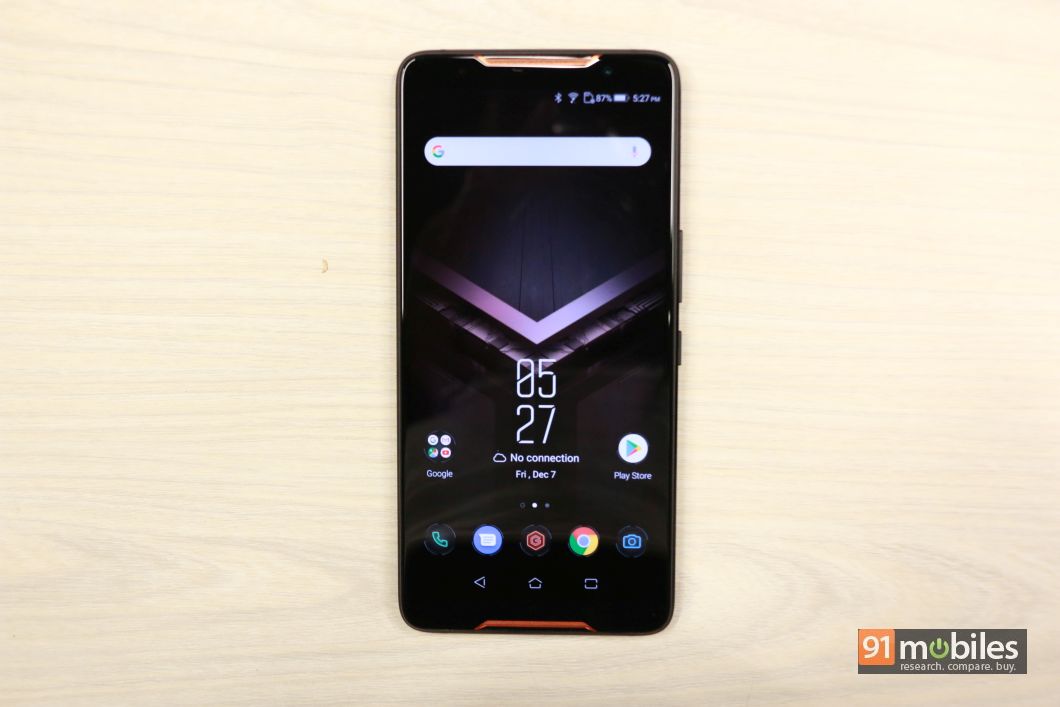“Our two cents on ASUS’ first gaming smartphone — the ROG Phone”
I could be preaching to a choir here, but I love playing games on my PS4. That being said, of all the incredible titles I played this year, Tencent Games’ PUBG for Android is quite possibly the one I’ve devoted the most hours to. What’s more, thanks to the growing library of top-quality games on Android, I constantly find myself reaching for my smartphone rather than my console to kill enemies.
Suffice it to say, mobile gaming is on the rise and smartphone vendors are starting to take note. Brands like Razer, Xiaomi and nubia are now offering prospective buyers a smartphone geared towards gaming and recently, ASUS joined the ranks with its ROG Phone (first impressions). I recently got a chance to review the smartphone and after spending a week with the device, here’s what I make of it.
Table of Contents
Specs at a glance
Design: the apple doesn’t fall far from the tree
Let’s kick things off by talking about the design of the smartphone, which is undoubtedly the most polarising aspect of the device. You see, the folks at ASUS drew inspiration from the company’s gaming laptops and have fashioned the ROG Phone in a similar aesthetic. Consequently, the handset features an edgy design which screams “gaming phone” like no other in the market. Be it the unique-looking cutouts at the back for the camera module and the fingerprint sensor, or the brand’s massive logo which lights up in 16 million different colours, the ROG Phone is the most gaming phone money can buy.
Now, if you’re a fan of elegantly styled devices which pay heed to symmetry, you might be better suited to the latest flagship from Samsung or Apple. However, if you fancy something different and edgy, then the ROG Phone will not disappoint you.
I’d also like to point out that not all elements of the smartphone’s design are just for show and some actually do serve a purpose. Take the copper accents at the back of the device – they sit on top of a 3D vapour chamber deployed by ASUS to keep the ROG Phone cool during intense gaming sessions. You also get IPX4 splash-resistance with the device, which will protect the device if you accidentally spill water on it. Then, there’s the 48-pin customised connector with two USB Type-C ports positioned on the left spine of the device which lets you connect various accessories like the bundled AeroActive cooler to the smartphone.
More importantly, if you’ve ever struggled with gaming on your smartphone whilst it was connected to a charger, you can use one of the two USB Type-C ports to charge the ROG Phone too. This scheme ensures that you get an excellent grip on the device which is unhindered by wires or cables. As a matter of fact, during my week-long stint with the ROG Phone, I’d all but forgotten about the single Type-C port positioned at the bottom of the device.
Unfortunately, the design of the smartphone is not without its flaws. The fingerprint sensor, for instance, is just not reliable. It’s not so much the shape of the sensor but the positioning which made it extremely difficult for me to unlock the device in one go. Thankfully, ASUS does include face unlock with the device, which worked flawlessly during my testing. It’s not as secure as the fingerprint sensor, but, it’s more dependable and convenient. Then, there’s the sheer weight of the unit itself, which makes using the smartphone over long hours feel like an arm workout. Coupled with the handset’s slippery back, I couldn’t muster the courage to use the smartphone single-handedly during my review period.
On the flip side, the smartphone comes equipped with a headphone jack and can even play 24-bit, 192KHz Hi-res audio files. What’s more, you’ll also get two awesome-sounding front-firing speakers with the ROG Phone which get plenty loud and don’t distort the audio at high volume levels. Last but not the least, the smartphone comes equipped with pressure-sensitive inputs along its sides which the company calls AirTriggers. I’ll talk more about their utility later in the review, but simply put, they are designed to mimic the trigger buttons you might have seen on an Xbox or a Playstation controller.
Display: smoother than your best pickup line
The ASUS ROG Phone ships with a 6-inch, 18:9 aspect ratio, Full HD+ AMOLED display with a refresh rate of 90Hz. Now, most of the display’s specs are a pretty standard affair, however, the panel’s higher refresh rate gives the ROG Phone an edge over the herd of other flagships. You see, the refresh rate of a display is the speed at which the unit refreshes or changes an image. Consequently, a panel with a higher refresh rate will be able to keep up with a player’s quick movements within a game (provided the game is outputting comparable frame rates).
Unfortunately, only a handful of Android games can benefit from the display’s high refresh rate at the moment and even those titles don’t utilise the panel’s capabilities to the fullest. For a game to make the most of the ROG Phone‘s display, it needs to run at 90fps or more and generally speaking, Android titles barely touch the 60fps mark. That said, I am confident that buyers opting for the device will also use it for normal phone stuff, and that’s where the display shines (quite literally).
You see, once you’ve acclimated yourself to the UI animations and the smartphone’s responsiveness at 90Hz, you’ll find it jarring to go back to a 60Hz display. The swipes are buttery smooth and functions like pinch to zoom in/out feel oddly satisfying too. What’s more, since the smartphone comes equipped with an AMOLED panel, you’ll be able to feast your eyes to excellent contrast levels and vibrant hues. Lastly, if you’re worried about scuffing the display when the smartphone is in your pocket, you should know that the ROG Phone is among the handful of smartphones in India to come equipped Corning’s Gorilla Glass 6 layer on top of the panel.
Performance: a Bugatti with NOS
Remember the 3D vapour chamber I mentioned at the beginning of my review? Well, that’s been put in place to keep the overclocked processor powering the ROG Phone from throttling. The processor in question is a speed-binned SD 845 chip clocked at a whopping 2.96GHz. The chip works alongside 8 gigs of RAM and 128GB of built-in, non-expandable memory.
Unsurprisingly, the ROG Phone breezes through tasks and games like nobody’s business. During the entirety of my review period, I didn’t come across a single instance of lag or stutter on the smartphone. What’s more, the handset was quick to launch intensive games like PUBG and could comfortably hold over a dozen apps in memory at any given instance.
That being said, the OnePlus 6T (review), which has been my daily driver for the past few months, is just as good at handling CPU intensive tasks and games, which begs the question – why buy the ROG Phone in the first place? Quite frankly, the performance delta between a high-end flagship such as the OnePlus 6T and the ROG Phone isn’t all that much. In fact, during my testing, the only noticeable difference in performance I observed was that the ROG Phone handled thermals slightly better than my OnePlus 6T.
While we’re on the subject of playing PUBG, let’s talk about the Air Triggers which can be found on either side of the ROG Phone. During my testing, I programmed the trigger on the left-hand side of the phone to bring up the scope in the game. Unfortunately, pressing the trigger meant having to readjust my grip during intense battles, which just didn’t feel as seamless as I thought it would. Consequently, my game suffered quite a bit, leaving me with no other alternative but to turn the functionality off.
Software and battery life: not for everyone
The ASUS ROG Phone boots Android Oreo 8.1 with a skin of ROG UI on top. The UI is a far cry from stock Android and I feel that ASUS has tried a little too hard to make the interface feel gamer-y. That being said, the beauty of using an Android smartphone is that you can customise it the way you deem fit. Moving on, the handset also ships with a ton of pre-loaded apps from ASUS, including the likes of Game Centre, which gives you insights on the smartphone’s core components like the RAM, the GPU as well as the CPU.
Everything considered, while the software on board the ROG Phone operates perfectly well, I would’ve preferred if ASUS took a more subdued approach towards the design of the interface.
The battery life of the ASUS ROG Phone is about as good as one would expect from a device backed by a speed-binned Snapdragon 845 chip which is powering a 6-inch display with a high refresh rate. In short, it’s not very good.
Despite shipping with a 4,000mAh cell, I was barely getting three hours of screen on time with the smartphone. Thankfully, the handset fuels just as quickly as it drains, and I didn’t have to stay tethered to the charger for a long time.
Cameras: not quite the sharpshooter
The ASUS ROG Phone ships with a pair of sensors at the back, comprising a 12MP f/1.7 lens with Sony’s IMX363 sensor and a 120-degree wide-angle camera. For selfies, the handset features an 8MP shooter with f/2.0 aperture. While the camera setup seems promising on paper, the sensors leave a lot to be desired when you’re using them to click photos.
Let’s talk about the dual-rear cameras first. The images I clicked with the device looked brilliant on the smartphone’s display and exhibited vibrant colours and good dynamic range. However, upon zooming in, I noticed that the smartphone was aggressively sharpening the subject, which took most of the charm away from the shots. What’s more, you’ll notice that the smartphone softens the skin tone quite a bit, especially when you use the built-in portrait mode.
Speaking of which, the handset struggles to separate the foreground from the background in portrait images properly and many a times, I noticed that the blur effect crept into the parts which should’ve been in focus.The situation takes a turn for the worse when you switch to the wide-angle camera. Not only is there a noticeable fisheye effect, but the images are void of any details once you zoom in.


As for low-light photography, the pictures I took with the smartphone at night had considerable noise and grain in them. Thankfully, the smartphone somewhat redeems itself by offering a decent selfie camera, however on the whole, the ROG Phone is clearly inferior to other similarly priced flagships in the imaging department.
That’s quite surprising, as the cameras bundled with the device are quite capable shooters. I hope that a software update in the future fixes some of the issues I faced in the imaging department. Of late, ASUS has built a solid track record when it comes to seeding timely software updates, as we’ve already seen with the brand’s Zenfone 5Z.
Yay or Nay?
So, should you be paying lavishly for the privilege of owning a gaming smartphone from ASUS? Well, the answer to that depends on how deep your pockets run and how badly you want to own a ‘gaming smartphone’. Quite frankly, it’s hard to justify paying Rs 70,000 for the ASUS ROG Phone when you can get an equally powerful flagship for half the cost. Even if you could justify the marginal performance improvements you might get with the ROG Phone, the smartphone’s lacklustre cameras and below-average battery life stick out like a sore thumb.
While you could make an argument for the handset’s gorgeous design and the high-refresh rate display, it’s going to take a while for Android games to adapt to a 90Hz panel. Until that happens, I feel that the ASUS ROG Phone is a novelty at best, designed to appease only the most hardcore gamers. However, there’s no denying that the handset is also a flag-bearer for a completely new segment in India and I can’t wait to see where ASUS’ ambition leads us next.
Editor’s rating: 3.5 / 5
Pros:
- Awesome display
- Gorgeous and unique design
- RGB logo!
- Solid sound output
Cons:
- Expensive
- Below-average battery life
- Sub-par cameras














































